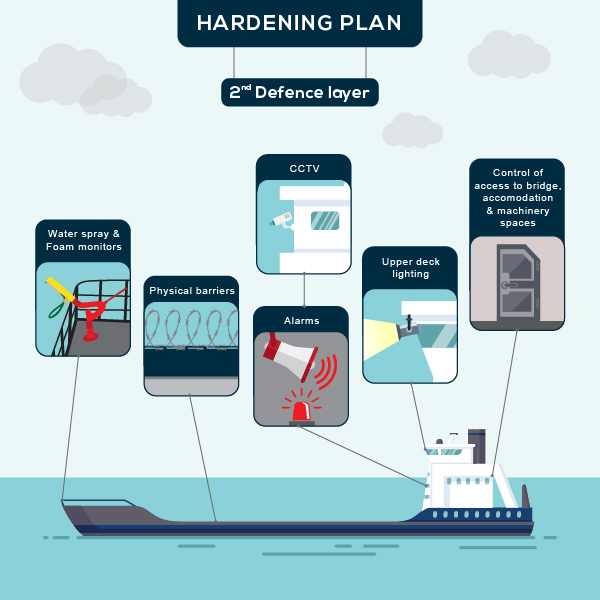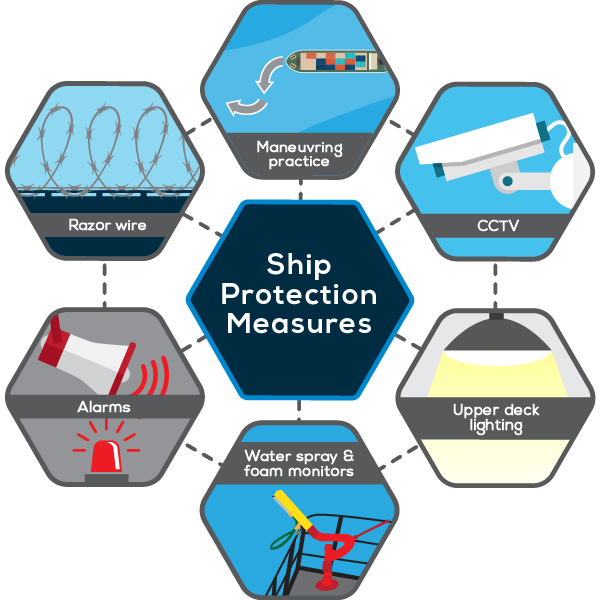Ship hardening measures are all physical security measures taken with the aim to improve vessel’s integrity in security threats which can be achieved through three defense layers; either with the implementation of operational measures (1st defense layer) i.e. watchkeeping, maneuvering, speed, armed security contractors, or with equipment related measures (2nd defense layer or with citadels onboard (3rd defense layer).
OCIMF highlights that any vessel hardening measures adopted should not compromise the vessel’s compliance with SOLAS regulations. Escape routes should be kept clear and nothing should interfere with the crew’s ability to respond to non-security related emergencies. In addition, it is recommended all companies to always complete a thorough security risk assessment and identify and implement mitigation measures.

Key items for an effective ship security hardening plan
In line with the requirements of the latest OCIMF Guidelines for Hardening Vessel (July 2018) all ships need to be provided with a Hardening Plan. A ship security hardening plan provides guidance to onboard personnel for equipment use, procedures and applicable points related to vessel’s hardening. The following six equipment related measures are important for enhanced security onboard:
#1 Control of Access to Bridge, Accommodation and Machinery Spaces
It is very important to control access routes in order to deter or delay pirates who have managed to board a vessel and are trying to enter accommodation or machinery spaces. It is strongly recommended that significant effort should be expended prior to entry a High Risk Area in order to prevent a pirate’s access to the accommodation and bridge.
#2 Upper Deck Lighting
Another recommended measure is the use of lighting. More specifically the weather deck lighting around the accommodation block, the rear facing lighting on poop deck and the search lights should be tested and accordingly maintained in order to immediately be used when required. It is also recommended for ships proceed with just their navigation lights illuminated, keep the lighting described above extinguished as, once pirates have been identified or an attack commences, to immediately illuminating the rest of the lights and demonstrate to the pirates that they have been observed. In addition, navigation lights should not be switched off at night.
#3 Alarms
If pirates approach the vessel continuous sounding of foghorn/whistle would distract them and they will be aware that they have been seen. It is important to ensure that the piracy alarm is distinctive to avoid confusion with other alarms and the crew is familiar with the sound. Exercises should be carried out prior to entering the High Risk Area.
#4 Closed Circuit Television (CCTV)
The use of CCTV coverage allows a degree of monitoring the progress of the attack from a less exposed position and provides useful evidence after an attack. In order to be effective, it is useful to cover the vulnerable areas, particularly the poop deck and the rear of the bridge. Further CCTV monitors could be located at the Safe Muster Point/ Citadel
#5 Physical Barriers
Pirates typically use long lightweight hooked ladders; grappling hooks with rope attached and long hooked poles with a climbing rope attached to board vessels underway. Physical barriers should be used to make it as difficult as possible to gain access to vessels by increasing the height and difficulty of any climb for an attacking pirate. Razor wire (also known as barbed tape) creates an effective barrier but only when carefully deployed. Care should be taken when selecting appropriate razor wire as a lower quality razor wire is unlikely to be effective.
#6 Water Spray and Foam Monitors
The use of water spray and/or foam monitors has been found to be effective in deterring or delaying pirates attempting to board a vessel. The use of water can make it difficult for a pirate skiff to remain alongside and makes it significantly more difficult for a pirate to climb onboard. Options include:
- Fire hoses and Foam monitors
- Water cannons
- Ballast pumps
- Steam
- Water spray rails
- Foam can be used, but it must be in addition to a vessel’s standard Fire Fighting Equipment (FFE) stock.

Overall, considering that pirate attacks on vessel are a serious threat for human life, shipping organizations should implement a Ship Security Plan that meets the requirements of ISPS Code as a minimum standard. What’s more, crew members onboard need to be trained in accordance with STCW requirements regarding security and attend all required security drills issued by the approved Security Plan. Therefore, it is company’s responsibility to continuously promote a secure working environment onboard in order to ensure that crew will have a plan as guidance to safeguard the vessel during transits in High Risk Areas or other areas with increased piracy activity.
































































